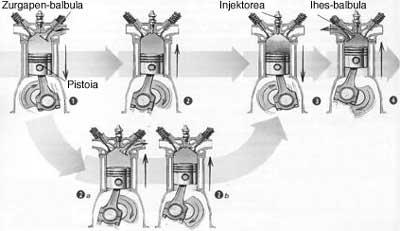Miller cycle in explosion engines

In explosion engines running with pistons and cranks there are two ways to improve performance: increase compression ratio and extend propagation after explosion. In classic four-stroke engines, however, the compression rate cannot rise above a measure, as the mixture of fuel and air before the piston reaches the top point is spontaneously inflamed.
Moreover, the expansion phase cannot be prolonged without increasing the compression ratio. In fact, the volume that moves when the piston rises in compression is the same as the one that moves in the propagation of the burned gases down after the explosion. The expansion ratio is therefore equal to the compression ratio.
This barrier can be avoided in injection engines thanks to the Miller cycle. The Mazda house has improved the Miller cycle and the compression time is basically shorter than the expansion time, as the absorption valves are fired later.
The four phases of the explosion engine are:
- The piston starts sucking up and down air from the open absorption valve.
- When the piston starts from bottom to top, in the first fifth part of the piston stroke the absorption valve remains open (2nd. Compression is performed in the other four fifths (figure 2.b). Image). Therefore, in compression four fifths of the route are used.
- When the piston is above, fuel is injected and the piston takes from top to bottom the propagation force of the burned gases throughout the course.
- When the piston arrives from the bottom up, the burned gases go outside the exhaust valve.
Therefore, the thrust of the burned gases is collected in a longer route than in a conventional motor with the same compression ratio. As a result, engine performance is better and Mazda engineers expect to reduce fuel consumption by 10-15%.





